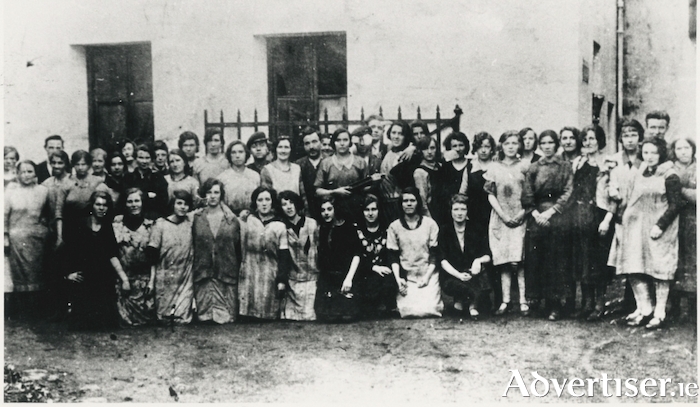In 1895, the Galway Woolen Mills opened in Newtownsmith on land that was owned by Marcella Burke. The project was set up to provide employment, especially for young women, rather than to generate profits. Fr Dooley, the diocesan administrator, was the driving force behind the project and it was known locally as “Fr Dooley’s Mill’ long after he died in 1911. He took over three houses in order to build the mill. The hours were long and the pay was not great, 7/6 for women and 18 shillings for men.
It became a successful business. Just before World War I, the wage bill was £5,000, after the war it was £15,000, and in 1919, profits to the amount of £5,772 were distributed among the staff.
We quoted Jane Hackett in this column last week on her work in the Corrib Hosiery factory until it closed down, after which she got a job in the Woolen Mills. This was how she described her work in the mills: “When I went there in the early 1930s, there were hundreds working there. It was a marvelous place, it gave great employment. There was people from Henry Street, Quay Street, College Road, Bohermore especially, and the Claddagh people, an awful lot of Claddagh people. There was quite a lot of men, mostly working on the heavy machinery, but it was mostly women. They made lovely tweeds, the only other thing they made were báinín material and red flanellette.
"I think the weavers were on piece-time. I couldn’t say what their wages were but it must have been good because all the women kept up their jobs. A lot of the women around here, married women with families, were weavers. We were only helping them, winding the thread up in the loft in the top of the house. We were winding the big cones of thread on the machines and they’d come up and collect them. A lot of the old people that were weavers when I came in started like I started and they were able to advance. I came in at the tail end of it before it closed down, so I didn’t have that chance.
"Some might leave when they got married, but others waited until they died. It was more or less a family affair: the mother would be there and the daughter would follow her into it. Before my time, there’d have been two or three, maybe four of the one family.”
A decline in business set in and in 1932 the mills were closed. A deputation of TDs and businessmen went to Leinster House looking for help in starting up again, but they were unsuccessful. Eventually, a group of city businessmen got together, formed a private company, and with a capital of £12,000, they reopened in 1934 and set the machines in motion again. Sadly, due to a lack of capital, it closed down again in 1939. James O’Flynn & Co from Sixmilebridge took over the company and quickly had it up and running again, as you can see from our advertisement published in The Irish Times on July 27, 1940. They did very well during the war years and stayed in business until 1957, when the death of the principals and some labour troubles forced the hand of the owners and they decided to close down. The building, which ran almost the length of Newtownsmith, went on fire in 1960 and was eventually replaced by the Convent of Mercy Secondary School.
Our main photograph is of four men preparing for a parade or procession in 1913 and showing off their banner with obvious pride, a banner for “Muilionn Olna na Gaillimhe” or the Galway Woolen Mills. It was unusual in that it represented a commercial firm, they usually represented workers' cooperatives, unions or guilds. Many trade banners were made in 1898 for the centenary of the Rebellion, others in 1903 for the Emmett centenary. The men are Mr Murray who had a wool shop in Shop Street, ------- , Mr Spinks, a Cork man who made warps, and John Quirke, an expert with a loom. The banner was made by Patrick Kavanagh of St Patrick’s Avenue. The other image is of some of the staff of the mills and dates from 1910. The Jane Hackett quotation is taken from a book entitled Growing up in Galway: Histories and Memories, edited by Sarah-Anne Buckley and John Cunningham and published by Eva Books with support from Galway City Museum in 2017.
Would you like unlimited FREE access to all that the Galway Advertiser has to offer? Find out more here!

